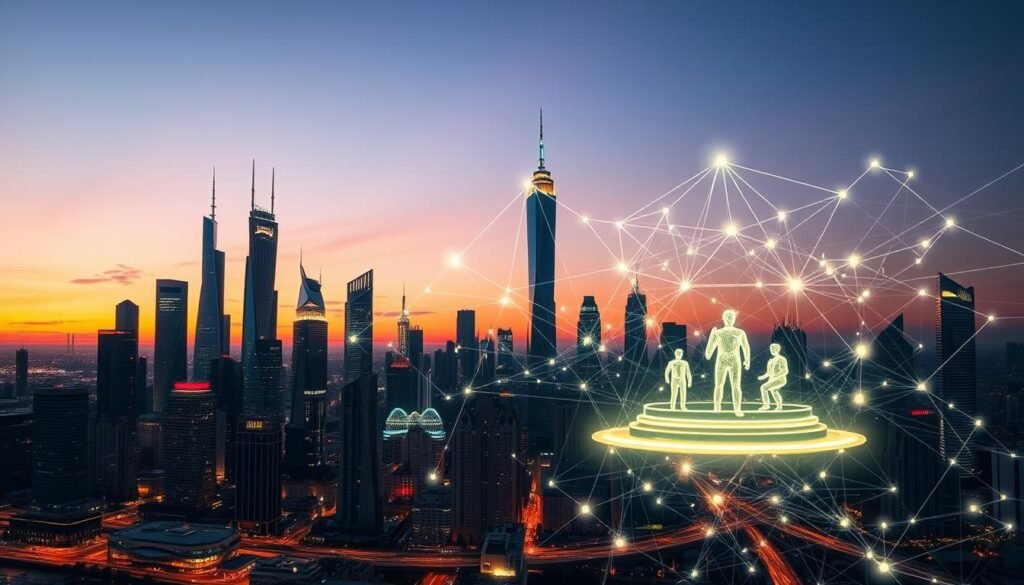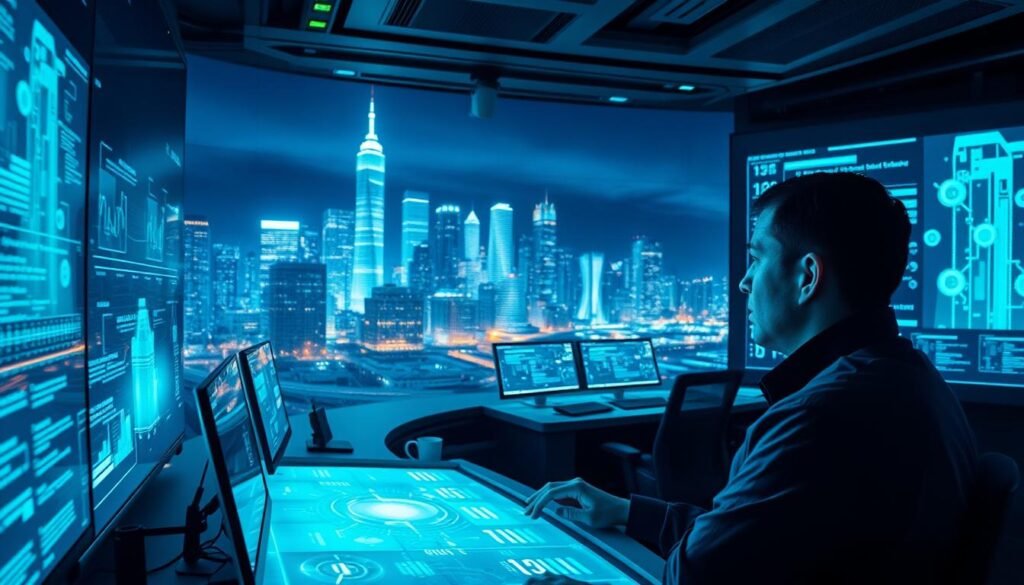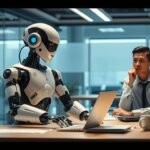Can AI truly protect us in a digital world where cyber threats evolve faster than we can react?
As we move towards 2025, AI in cybersecurity is changing how we defend against cyber threats. AI can look at huge amounts of data quickly. This helps spot risks early and make fast, smart choices.
AI uses machine learning and agentic AI security to get better over time. It learns from past cyber attacks. This makes defenses faster, more accurate, and efficient.
By 2025, AI’s role in fighting off complex threats will be clear. Autonomous AI systems can act quickly. This changes how we handle cyber threats, keeping your digital security strong against new challenges.
Key Takeaways
- AI-powered threat detection speeds up the identification and response to cyber threats.
- Machine learning enables AI systems to learn from past incidents, improving accuracy.
- Agentic AI security allows for autonomous, real-time responses to cyber risks.
- The integration of AI in cybersecurity is vital for staying ahead of sophisticated threats.
- By 2025, AI will be an essential component in maintaining robust digital defenses.
The Evolution of AI in Cybersecurity
AI in cybersecurity has grown a lot, from simple beginnings to today’s advanced systems. This growth helps us see how our security plans have changed and gotten better over time.
Early Stages: Rule-Based Systems
In the early days, AI systems used rules to spot threats. But these systems had to know the patterns beforehand. This led to many false alarms and missed threats. Yet, they were the first step in using AI for security, showing how to find and fight threats.
Rise of Machine Learning
As AI got better, machine learning became key in security. It could look at past data to find new patterns, unlike the old rule-based systems. This change made security systems more flexible and good at catching new threats.
Deep Learning and Advanced Detection
Deep learning changed AI security big time. It could dig deep into data to find complex threats. This move from just reacting to threats to predicting them was a big leap forward in AI security.
- Initial rule-based systems for early AI cybersecurity.
- Machine learning enhanced detection abilities.
- Deep learning brought advanced threat analysis and prediction in cybersecurity.
AI-Powered Threat Detection
In the world of cybersecurity, AI-powered threat detection is a big step forward. It uses advanced tech like predictive ML security and behavioral analytics. Now, systems can spot and stop threats before they cause damage.
Predictive Machine Learning Algorithms
Predictive ML security uses machine learning to predict threats. It looks at past attacks and behavior to find weak spots. This way, it can warn of future attacks, helping organizations stay safe.
Behavioral Analytics
Behavioral analytics in cybersecurity is key to finding odd behavior and insider threats. AI creates detailed profiles of users. It watches for changes in behavior that might not be caught by old systems.
This mix of AI and behavioral analytics makes security smarter and more flexible. It’s a big change from old, fixed systems. AI helps defend against new and complex cyber threats.
Agentic AI Security Techniques
Agentic AI security is a big step forward in AI. It lets AI systems find and fight cyber threats on their own. They look at security data, change plans as threats come up, and take steps like isolating attacks.
This quick action helps keep systems safe. It cuts down the time it takes to spot and act on threats.
Agentic AI uses smart AI methods to work alone. It makes fast, smart choices. This helps human teams focus on bigger tasks and strategy.
This makes the defense stronger and more ready to adapt to new threats.
Agentic AI security paves the way for a future where AI-driven defense mechanisms can outpace cyber threats, ensuring stronger and more resilient cybersecurity infrastructure.
Using AI systems that work on their own helps fight cyber attacks better. It adds a new layer of protection. As these systems get better, we might see fully self-sustaining security systems soon.
Core Components of Autonomous Cyber Defense
In our fast-changing digital world, autonomous cyber defense is a strong shield against cyber threats. It combines advanced technologies and smart systems for strong and flexible security.
Automated Threat Intelligence
Automated threat intelligence is key to autonomous cyber defense. It uses smart machine learning to analyze big data and spot threats. These systems collect and analyze threat data from all over the web, helping your security stay ahead of bad actors.
Real-Time Response Systems
Real-time cyber response systems act fast when threats are found, cutting down damage. They can tell good from bad activity and take action right away. This keeps your organization safe all the time, reducing downtime and keeping things running smoothly.
Network Detection and Response (NDR)
NDR systems are vital for protecting your network. They watch network traffic for signs of trouble or odd behavior. If they find something wrong, they can take action to stop it, keeping your data safe. NDR systems are a key part of keeping your network safe and secure.
These main parts—automated threat intelligence, real-time cyber response, and NDR systems—make a strong defense. They work together to protect you well, using smart tech to keep you safe from cyber threats.
AI in Identity and Access Management
Artificial intelligence (AI) is changing how we protect sensitive information. It works with identity and access management (IAM) systems. AI looks at how people access data to make sure only the right ones can.
Let’s look at two key areas where AI is making a big difference.
Improving Access Controls
AI helps make access controls better by checking user identities in real time. Old methods can’t always keep up, but AI uses big data to get it right. It changes access rights based on what users do and how risky it is.
Reducing Insider Threats
AI is great at spotting insider threats. It watches how users act and finds odd patterns that might mean trouble. This alerts security teams to check things out, stopping bad things from happening.
Adding AI to IAM systems really boosts security. It protects against both outside hackers and insiders who might try to do harm.
AI Governance in 2025
By 2025, AI governance will balance automation and human oversight. This balance ensures AI boosts efficiency without replacing human judgment in cybersecurity. It focuses on regulations that make AI decisions transparent and fair, protecting privacy and preventing biases.

Balancing Automation and Human Oversight
The heart of AI governance in 2025 is finding a balance between AI and human oversight. AI can quickly analyze data and spot anomalies, but human experts are key in complex decisions. This mix helps avoid risks from relying too much on AI.
Having humans check AI decisions is vital. It stops AI from causing problems and keeps its actions in line with ethical standards.
Regulations and Ethical AI Practices
AI rules and oversight are key to using AI ethically in cybersecurity. These rules aim to ensure AI decisions are clear and unbiased. By 2025, these rules will have grown to cover AI’s role in security, guiding ethical use.
Following these guidelines will help companies use AI wisely. It ensures AI is fair, open, and accountable, upholding important values.
AI Cybersecurity Trends, Agentic AI Security, AI-Powered Threat Detection
Cybersecurity is changing fast, with new trends leading the way. AI is playing a big role in fighting cyber threats. Agentic AI security systems are key, acting on their own to protect us.
AI is also helping spot threats quickly. It looks at lots of data fast, making it better at finding danger. This combo of AI and agentic AI security makes our defenses stronger.
The future of cybersecurity lies in the intelligent application of AI technologies, which promise to revolutionize how threats are managed and mitigated.
AI is making security systems smarter and more independent. Here’s how old methods compare to new AI ones:
| Aspect | Traditional Cybersecurity | AI-Driven Cybersecurity |
|---|---|---|
| Threat Detection | Manual and signature-based | AI-powered threat detection and predictive analysis |
| Response Time | Slower, dependent on human intervention | Real-time, autonomous action |
| Adaptability | Limited by predefined rules | Highly adaptive through machine learning |
| Scalability | Challenging and resource-intensive | Effortless scaling with cloud-based AI solutions |
Using AI in cybersecurity helps businesses fight threats better. With agentic AI and AI threat detection, they can keep their digital world safe.
The Role of Explainable AI Tools
In the world of cybersecurity, explainable AI tools are key. They help experts understand AI’s decisions. This is important for trust and following rules.
Importance of Transparency
Being open about AI is vital. When we know why AI makes certain choices, we feel more secure. This openness helps us fix problems and make the system better.
Avoiding “Black-Box” Systems
It’s important to avoid AI systems that are too secret. These systems are hard to check and can be risky. Explainable AI tools make things clear, so we can trust and follow rules better.
Predictive Machine Learning in Security
Predictive machine learning security is changing how we fight cyber threats. It’s not just about reacting to attacks. This new approach uses machine learning to predict threats before they happen.

This shift means using algorithms to forecast attacks. These algorithms look at past data and current trends. This makes cyber defense systems more efficient and quicker to respond to threats.
| Approach | Reactive Security | Predictive Machine Learning Security |
|---|---|---|
| Threat Detection | After occurrence | Before occurrence |
| Response Time | Delayed | Immediate |
| Efficiency | Moderate | High |
Using predictive machine learning security helps businesses stay ahead. It lets them identify and stop threats in real-time. This gives them an edge over traditional methods that only react after an attack.
The Intersection of AI and Quantum-Resistant Cryptography
At the crossroads of AI and quantum computing, the future of data encryption is being redefined. As quantum computing advances, current cryptographic methods face the risk of becoming obsolete. This intersection necessitates the development of quantum-resistant solutions to safeguard sensitive information.
Potential Threats from Quantum Computing
Quantum computers can break traditional cryptographic algorithms, posing a big threat to data security. Their remarkable computational power makes traditional encryption vulnerable to fast decryption. This emerging threat calls for quantum-resistant cryptography to keep data safe and confidential.
Developing Quantum-Resistant Solutions
Integrating AI into cybersecurity strategies is key in developing quantum solutions. AI-driven systems can spot weak points in current cryptography and suggest strong, quantum-resistant methods. By using AI and quantum computing, experts can create encryption that can withstand quantum attacks, ensuring data protection for the future.
Through collaboration and innovation, the advancement of AI and quantum-resistant cryptography can protect your digital assets against quantum computing’s transformative power.
AI-Driven Security Operations in Enterprises
You’re dealing with a world full of changing threats. AI-driven security operations are now key in Security Operations Centers (SOCs). They help companies stay safe in a fast-changing world.
AI in SOCs brings a new way to fight threats. Let’s dive into how this change works.
Integration in Security Operations Centers (SOCs)
Adding AI technologies to SOCs makes threat detection better. With SOCs AI integration, tasks like watching and checking are done by AI. This lets humans focus on solving big cyber problems.
An AI-powered SOC finds problems quicker. This means less time to spot and fix threats.
AI-Enhanced Incident Response
Enterprise security AI does more than just find threats. It helps respond to them fast. AI gives quick insights and acts fast, helping teams react quickly.
This makes companies stronger and less hurt by security breaches.
In today’s digital world, using AI for security is a must. It keeps companies safe and strong.
Future Prospects of AI in Cyber Defense
The world of cybersecurity is changing fast with emerging AI security technologies and advancements in AI-driven security. These new tools promise to make security more precise and flexible. They are setting the stage for next-gen cybersecurity technology solutions.
Emerging AI Security Technologies
New models are going to change how we detect threats. They use smart algorithms to spot and stop risks before they happen. This means faster and more accurate defense against cyber threats.
Advancements in AI-Driven Security
AI tools are getting better all the time, which is key for cyber defense. These updates help create more flexible security plans. By using next-gen cybersecurity technology, companies can improve their security and work more efficiently.
To grasp the impact and future of emerging AI security technologies and advancements in AI-driven security, look at these points:
| Aspect | Current State | Future Prospects |
|---|---|---|
| Threat Detection | Reactive, often delayed | Proactive, real-time |
| Response Mechanisms | Manual intervention required | Automated, AI-driven responses |
| Operational Efficiency | Fragmented processes | Integrated, streamlined workflows |
Conclusion
AI is changing the world of cybersecurity in big ways. It helps find threats faster and makes defense systems smarter. This makes our digital world safer.
AI is getting better at spotting threats and making security systems work better. It’s all about using AI to keep our digital world safe. This is a big deal for keeping our data and systems safe.
AI is just starting to show its power in cybersecurity. By using the latest AI tools, we can protect ourselves better. The future of keeping our digital world safe looks very promising.



